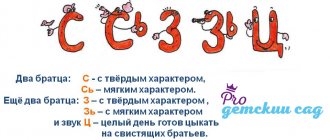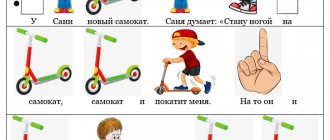Characteristics of hissing sounds and their articulation.
The group of hissing sounds includes the sounds sh, zh, ch, sch
.
Sound sh
consonant, deaf, hard. There is no corresponding soft sound in the Russian language.
When pronouncing the sound sh
Normally, the speech organs take the following position:
- the lips
are slightly pushed forward;
the tip of the tongue
is raised to the palate (to the alveoli), but does not touch it, forming a gap;
the lateral edges of the tongue
are pressed from the inside to the upper molars or hard palate, without allowing a stream of exhaled air to pass along the sides.
Thus, the tongue takes the shape of a ladle or cup. the vocal cords
are open, the stream of exhaled air passes freely between them;
the air stream
is exhaled evenly in the middle of the tongue, it is strong, wide, warm, and can be easily felt with the back of the hand raised to the mouth.
Any deviation from the correct articulation pattern leads to sound distortion. When producing a sound, our main task is to create in the child the correct articulation of this sound.
Articulation of sound
differs from the articulation of the sound
sh
in the presence of a voice.
Articulation of sounds
and
ch
differs from the articulation of the sound
sh
by the additional rise of the middle part of the tongue towards the palate.
In addition, the sound h
is a closure-fissure, i.e., when it is articulated, the front part of the back of the tongue first closes with the alveoli, and then a gap is formed between them.
Thus, for hissing sounds sh, zh, shch, ch
the main one is the articulation of the sound
sh
, which means it will be basic for this group.
That is, work on correcting hissing sounds must begin with the sound w
.
If the sound w
is pronounced correctly, then by adding a voice we get the sound
w
;
by adding the rise of the middle part of the tongue, we get w
;
adding the rise of the middle part of the tongue and the bow in front of the gap, we get h
.
Therefore, violations of the sounds zh, shch, ch
are the same as those of
w
.
Promoting speech development in children
In order for the child’s speech to develop correctly, in accordance with age, parents, in consultation with a speech therapist, must carry out the following work:
- create a favorable communication environment, speak clearly and competently, do not distort words;
- Explain to your child all your actions (this is important for quickly mastering concepts);
- gradually generalize concepts, form semantic connections;
- show manipulations with various objects, ask them to repeat and pronounce their actions;
- play with the child, read with him.
The production of the sound Ш is carried out in stages; it is necessary for the formation of beautiful and clear speech. Classes are held not only with a speech therapist, but also at home. To quickly achieve a positive result, it is recommended to work with the child 2 – 3 times a day.
Corrective work in the absence of the sound Ш in speech.
Preparatory stage.
When starting to work on hissing sounds, you need to check whether the child can lift the tip of the tongue by the upper teeth and whether he can make the tongue wide (spread it). If these movements make it difficult for the child, they are practiced using special exercises.
To develop the ability to keep the tongue wide and freely spread, the child is asked to place it on the lower lip, then lightly slap his lips, as if pronouncing the sound combinations five-five-five
.
Then they develop the ability to bend the wide tongue upward in the shape of a cup. To do this, it is best to slightly stick out your wide tongue and show how its front edge can be pressed against the upper lip. If the child is unable to move, you can place the handle of a teaspoon under the tip of his tongue and, lifting it, press it to his upper lip.
Having mastered the movement, the child can repeat it with his mouth wide open, gradually moving his tongue behind his upper teeth. You need to hold your tongue suspended in your mouth, without touching the tip to the palate (see the position of the speech organs when pronouncing the sound Ш).
Sound production.
After the child learns to spread his tongue and bend it upward, the adult suggests to him: “Open your mouth slightly, lift your wide tongue over your upper teeth, like me. Now blow on your tongue. Do you hear how the wind rustled? (Air, passing through a small gap between the front edge of the tongue and the palate, forms a pinch, a pinching sound).
It happens that a child blows with the sound x
, then the jet dissipates, the sound turns out fuzzy and distorted.
In this case, he should be told: “Blow on the tip of your tongue, as if pronouncing the sound s
, but keep your tongue up.”
Developing the correct sh
requires repeated repetition and the use of various images (the wind makes noise, a snake hisses, air comes out of a burst balloon, etc.).
The game form, combined with explanation, quickly focuses the child’s attention. Gradually, under the control of an adult, he begins to perform the required movements (round his lips and slightly move them forward) and correctly pronounce the sound sh
.
It must be remembered that when introducing a sound, you should never call it to a child, so as not to cause him to habitually mispronounce it.
When the sound is delivered and pronounced correctly by the child, you can move on to automating it in syllables, words and sentences.
Speech therapy classes
The most successful way to improve speech is to visit a speech therapist. Regular exercises help improve fine motor skills and the formation of an air stream, which plays a significant role in pronouncing sounds. The speech therapist will select a set of exercises based on the individual characteristics of the speech apparatus. Classes include games, learning tongue twisters and manual practices. If a child does not make contact with a stranger, home activities will be the most relevant.
Corrective work when the pronunciation of the sound Sh is distorted.
Disorders of the pronunciation of hissing sounds are called sigmatisms.
. There are interdental, lateral and nasal sigmatisms.
Interdental sigmatism.
With this type of violation, the sound sh
has a lisping tone. This is due to the fact that, in contrast to the normal position of the organs of articulation, the tongue is pushed between the upper and lower incisors, forming a flat gap with them, the back is lowered and does not form the back of the scoop. The air stream when you bring your palm to your mouth is weak and scattered.
Possible causes of sound distortion:
shortened hyoid ligament, making it difficult to lift the tongue to the palate; high and narrow hard palate.
Preparatory stage of correctional work:
exercises are carried out to lift the tip and front of the tongue by the upper teeth, producing a directed air stream;
the sound t
, which requires lifting the tip of the tongue by the upper teeth.
Sound production.
t
with an aspiration at a slow pace 4-5 times , hitting the tubercles behind the upper teeth with the tip of the tongue. We gradually teach the baby to lengthen the exhaled stream and not to hit the tubercles, but only to raise the tip of the tongue towards them.
After setting the sound, they move on to automation: they sequentially introduce the set sound into syllables (open, closed, with a consonant cluster), words and phrases.
Lateral sigmatism.
A child has lateral sigmatism if in the words he pronounces, instead of the sound sh
you hear a peculiar, squelching sound. In this case, one of the corners of the lips is slightly lowered or retracted, there may be a slight shift of the lower jaw to the left or right; the tongue is raised up and rests on the roots of the upper incisors or lowered behind the lower incisors; the back of the tongue forms a closure with the alveoli, mainly its left or right half, and the other half is lowered down; the lateral edges of the tongue are also lowered. When you bring your palm to your mouth, the air stream goes to the side (left or right) or comes out along both edges of the tongue, while normally the air stream should go strictly in the middle of the tongue.
Possible causes of sound distortion:
weakness of the muscles of one half of the tongue; lateral open bite.
Preparatory stage of correctional work.
The child is given exercises to strengthen the lateral edges of the tongue, uniformly raise the tip of the front part of the back of the tongue upward, develop an air stream running in the middle of the tongue, and practice the sounds
t
and
s
.
Sound production.
Using mechanical assistance (a flat, narrow, slightly curved handle from a teaspoon), lift the wide tongue by the upper teeth, push it back towards the tubercles (the edges of the spoon handle are approximately at the level of the fourth incisors), ask the child to lightly grasp the spoon with his teeth and pronounce the sound
s
(the front teeth are visible all the time).
After the sound is delivered, they move on to automation: they sequentially introduce the delivered sound into syllables (open, closed, with a combination of consonants), words and phrases.
Nasal sigmatism.
With this type of violation, the sound sh
is replaced by snoring (in the nose) or a sound similar to a deep
x
with a nasal tint. Unlike normal articulation, with nasal sigmatism, the speech organs occupy a neutral position, the tongue is lowered down and pulled into the depths of the mouth, the back of the tongue is raised up, connected to the soft palate, the lateral edges are lowered down. The air stream exits through the nasal cavity and not from the mouth.
Cause of sound distortion
in this case there is excessive tension on the back of the tongue.
Preparatory stage of correctional work.
With the help of special exercises, the child develops the ability to hold a wide spread tongue on the upper lip, the ability to direct an air stream to the tip of the tongue raised on the upper lip (exercise “Magician”);
sounds t
and
s
.
Sound production.
The child is asked, with his mouth open, to pronounce the sound
p
, and with the tip of the handle of a teaspoon brought to the hyoid frenulum, stop the vibration of the front part of the tongue - a hissing will be heard.
After repeated repetitions, you can cause a hiss by barely bringing the spoon to the hyoid frenulum; then remove the spoon and, bringing your teeth closer together, achieve the correct sound of w
.
If there is no sound r
, put the sound
sh
from the sound
s
with mechanical help.
The child is asked to pronounce the sound s
.
In this case, using the handle of a teaspoon placed under the front of the tongue (across), lift the tongue up and slightly move it back until the sound w
.
After the sound is delivered, they move on to automation: they sequentially introduce the delivered sound into syllables (open, closed, with a combination of consonants), words and phrases.
Stage 2. Gymnastics for the articulatory apparatus
Lip exercises
To warm up your lips, you can use speech therapy exercises:
- “We’ll be surprised and laugh.” The preschool child alternately makes a wide and narrow tube with his lips. A wide tube is in the “o” state, a “narrow” tube is in the “y” state. Nothing is said out loud, only the lips work.
- "Smile tube" Alternately, the child smiles widely, then makes a movement with his lips like the sound “o”.
Tongue exercises
Classic exercises are also used to train the tongue:
- “Delicious jam”, in which the tongue licks the lower lip, now to the left, now to the right.
- For the exercise “The Horse Is Galloping,” you need to “click” your tongue, imitating the horse’s step.
- “Elephant – Frog”: the lips alternately imitate either an elephant’s trunk or a frog’s smile.
- “Funny swing”: use the tip of your tongue to reach the upper teeth, then move down to the lower teeth.
- “Tick-tock”: with the tip of your tongue, imitating the movements of a watch, move left and right at different speeds.
- “Paints”: “color the palate” with the tongue.
All exercises are performed up to 10 times, but it is necessary to ensure that the baby does not get tired and exercises with interest.
A preschooler will quickly master the correct pronunciation of sibilants if the preparatory stage is carried out clearly, so they should not be neglected. The duration of such classes will depend on the individual development of the child and the state of his articulatory apparatus. Experts advise extending them if improvement does not occur after three sessions.
Corrective work when replacing the sound Ш with other sounds.
sh is replaced
another sound is called
parasigmatism
. There are labiodental, paradental, whistling and hissing parasigmatisms.
Labiodental parasigmatism.
With this violation, the sound sh
replaced by the sound
f
: hat - “fapka”, car - “muffin”, shower - “duf”. This happens because, unlike the norm, the organs of articulation in labiodental sigmatism occupy the following position: the upper teeth are close to the lower lip and form a gap through which an air stream passes, the tongue is pulled back and practically does not participate in the formation of sound. When you bring your palm to your mouth, the air stream feels narrow and cold.
Possible causes of sound distortion:
phonemic hearing impairment; prognathia (a malocclusion in which the front teeth of the upper jaw protrude far forward), laxity of the muscles of the front part of the tongue.
Preparatory stage of correctional work.
The child develops the ability to compare and distinguish by ear the sounds
sh
and
f
using pictures. Exercises are carried out to practice the movements of the lower lip down and up, lifting the wide front edge of the tongue up.
Sound production.
They make the sound
sh
by imitation, using visual control: the child watches in front of the mirror so that the lower lip is motionless, exposing the lower incisors (you can hold the lip with a finger placed in the dimple under it).
You can also place the sound sh
from the sound s
with
mechanical assistance, drawing the child’s attention to the correct position of the organs of the articulatory apparatus.
After the sound is delivered, they move on to automation: they sequentially introduce the delivered sound into syllables (open, closed, with a combination of consonants), words and phrases.
After automation, work on differentiation
(distinguishing) sounds
sh
and
f
.
Dental parasigmatism.
This type of violation is characterized by the following pronunciation feature: the sound sh
is replaced in the child’s speech by the sound
t
: hat - “slipper”, car - “matina”, shower - “dut”. In this case, the lips occupy a neutral position, the tongue closes with the alveoli behind the upper incisors, the back of the tongue is lowered down, a groove in the middle of the tongue is not formed, the lateral edges of the tongue are adjacent to the upper molars. When you bring your palm to your mouth, the air stream feels jerky and not smooth, as it should be normally.
Possible causes of sound distortion:
impaired phonemic hearing or decreased physical hearing; closed bite
Preparatory stage of correctional work.
The child develops the ability to compare and distinguish by ear the sounds
sh
and
t
, using pictures-symbols;
distinguish, on the basis of tactile sensations, the sounds sh
and
t
by the air stream (with
sh
- long-lasting, with
t
- jerky).
Exercises are also carried out to develop a long-term directed air stream; the position of the wide anterior edge of the tongue at the tubercles behind the upper incisors; sound is being processed with
.
Sound production.
Using visual control of correct articulation, as well as tactile (tactile) sensations, they achieve the correct pronunciation of the sound
sh
.
After the sound is delivered, they move on to automation: they sequentially introduce the delivered sound into syllables (open, closed, with a combination of consonants), words and phrases.
After automation, differentiation
(distinguishing) sounds
sh
and
t
.
Whistling sigmatism.
Sound sh
is replaced by the sound
s
: hat - “sapka”, car - “masina”, shower - “dus”.
In contrast to the position characteristic of the normal pronunciation of the sound w
, in this case the organs of articulation occupy a position characteristic of the normal pronunciation of the sound
s
: the lips are stretched into a slight smile, the teeth are close together and slightly exposed, the tongue is wide, lies at the base of the lower incisors, without touching at their tops, the back is wide, raised towards the alveoli and in the middle forms a groove-shaped gap with them, the lateral edges of the tongue close with the molars. When you bring your palm to your mouth, the air stream is narrow, cold, and goes along the midline of the tongue.
Possible causes of sound distortion:
hearing loss or phonemic hearing impairment.
Preparatory stage of correctional work.
The child is taught to compare and distinguish by ear the sounds
s
and
w
, using pictures-symbols;
make you feel the difference in the outgoing air stream when pronouncing the sounds s
and
sh
(with
s
- a cold stream, with
w
- a warm stream). With the help of special exercises, they practice the movements of the wide tongue upward, towards the front part of the hard palate, and achieve alternating movements of the wide tongue either for the lower or upper teeth; alternating movements of the lips: stretching into a smile, moving forward closed.
Sound production.
Using the technique of imitation, while drawing the child’s attention to correct articulation, they achieve the correct pronunciation of the sound
sh
.
After the sound is delivered, they move on to automation: they sequentially introduce the delivered sound into syllables (open, closed, with a combination of consonants), words and phrases.
After automation, work on sound ends with the differentiation
(distinguishing) between the sound
w
and the substitute sound -
s
.
Hissing sigmatism.
With this disorder, the sound is similar to the sound of a softened sound sh
: hat - “shchapka”, car - “mashina”, shower - “dush”. Unlike normal articulation, in this case the lips are rounded and slightly pushed forward, the tongue is lowered down and moves back or rests on the lower gums, a groove in the middle of the tongue is not formed, the lateral edges of the tongue are lowered and do not meet the molars. When you bring your palm to your mouth, the air stream spreads over the entire surface of the tongue.
Possible causes of sound distortion:
phonemic hearing impairment or hearing loss; progeny (malocclusion in which the front teeth of the lower jaw protrude far forward).
Preparatory stage of correctional work.
The child develops the ability to compare and distinguish by ear the sounds
sh
and
sh
. With the help of exercises, the ability to raise the wide front edge of the tongue to the tubercles behind the upper incisors is achieved; alternate movements of the wide tip of the tongue from the base of the upper incisors to the front of the hard palate (back and forth).
Sound production.
The child is asked to pronounce the sound
s
.
In this case, using the handle of a teaspoon placed under the front of the tongue (across), lift the tongue up and slightly move it back until the sound w
. Then they achieve this skill without mechanical assistance.
After the sound is delivered, they move on to automation: they sequentially introduce the delivered sound into syllables (open, closed, with a combination of consonants), words and phrases.
After automation, work on differentiation
(distinguishing) sounds
sh
and
sh
.
hissing sounds.
Before you start performing the exercises, be sure to read the recommendations for performing articulatory gymnastics.
Punish the naughty tongue.
Target.
Develop the ability to relax the muscles of the tongue and hold it wide and spread out.
Description.
Open your mouth slightly, calmly place your tongue on your lower lip and, smacking it with your lips, pronounce the sounds five-five-five... Keep your wide tongue in a calm position, with your mouth open, counting from one to five to ten.
Attention!
1.The lower lip should not be tucked in or pulled over the lower teeth. 2.The tongue should be wide, its edges touching the corners of the mouth. 3. You need to pat your tongue with your lips several times in one exhalation. Make sure that the child does not hold back the exhaled air. You can check the implementation like this: bring the cotton wool to the child’s mouth; if he does the exercise correctly, it will deviate. At the same time, this exercise promotes the development of a directed air stream.
Make your tongue broad.
Target.
Develop the ability to hold your tongue in a calm, relaxed position.
Description.
Smile, open your mouth slightly, place the wide front edge of your tongue on your lower lip.
Hold it in this position for a count of one to five to ten. Attention!
1.Do not stretch your lips into a strong smile so that there is no tension. 2.Make sure that your lower lip does not curl up. 3.Do not stick your tongue out far; it should only cover your lower lip. 4. The lateral edges of the tongue should touch the corners of the mouth.
Glue on some candy.
Target.
Strengthen the muscles of the tongue and practice lifting the tongue upward.
Description.
Place the wide tip of your tongue on your lower lip.
Place a thin piece of toffee on the very edge of your tongue and glue a piece of candy to the roof of your mouth behind your upper teeth. Attention!
1. Make sure that only the tongue works; the lower jaw must be motionless. 2.Open your mouth no wider than 1.5-2 cm. 3.If the lower jaw is involved in the movement, you can place the child’s clean index finger on the side between the molars (then it will not close the mouth). 4.The exercise must be performed at a slow pace.
Fungus.
Target.
Develop an upward lift of the tongue, stretching the hyoid ligament (frenulum).
Description.
Smile, show your teeth, open your mouth slightly and, pressing your wide tongue with its entire plane to the palate, open your mouth wide.
(The tongue will resemble a thin mushroom cap, and the stretched hyoid ligament will resemble its stem.) Attention!
1. Make sure that your lips are in a smiling position. 2.The side edges of the tongue should be pressed equally tightly - neither half should fall down. 3.When repeating the exercise, you need to open your mouth wider.
Who will kick the ball further?
Target.
Produce a smooth, long-lasting, continuous air stream running down the middle of the tongue.
Description.
Smile, place the wide front edge of your tongue on your lower lip and, as if pronouncing the sound f for a long time, blow the cotton wool onto the opposite edge of the table.
Attention!
1.The lower lip should not be pulled over the lower teeth. 2. You can’t puff out your cheeks. 3. Make sure that the child pronounces the sound f and not the sound x, that is, that the air stream is narrow and not diffuse.
Delicious jam.
Target.
Develop an upward movement of the wide front part of the tongue and a position of the tongue close to the shape of a cup, which it takes when pronouncing hissing sounds.
Description.
Open your mouth slightly and lick your upper lip with the wide front edge of your tongue, moving your tongue from top to bottom, but not from side to side.
Attention!
1. Make sure that only the tongue works, and the lower jaw does not help, does not “pull” the tongue upward - it must be motionless (you can hold it with your finger). 2. The tongue should be wide, its side edges touch the corners of the mouth. 3.If the exercise does not work, you need to return to the exercise “Punish a naughty tongue.” As soon as the tongue becomes spread out, you need to lift it up and wrap it over the upper lip.
Harmonic.
Target.
Strengthen the muscles of the tongue, stretch the hypoglossal ligament (frenulum).
Description.
Smile, open your mouth slightly, stick your tongue to the roof of your mouth and, without lowering your tongue, close and open your mouth (just as the bellows of an accordion stretch, so does the hyoid frenulum stretch).
The lips are in a smiling position. When repeating the exercise, you should try to open your mouth wider and wider and keep your tongue in the upper position longer. Attention!
1. Make sure that when you open your mouth, your lips are motionless. 2.Open and close your mouth, holding it in each position for a count of three to ten. 3. Make sure that when you open your mouth, one side of the tongue does not sag.
Focus.
Target.
Develop the ability to lift the tongue upward, the ability to shape the tongue into a ladle and direct the air stream in the middle of the tongue.
Description.
Smile, open your mouth slightly, place the wide front edge of your tongue on your upper lip so that its side edges are pressed together and there is a groove in the middle of your tongue, and blow off the cotton wool placed on the tip of your nose.
The air should go in the middle of the tongue, then the fleece will fly up. Attention!
1. Make sure that the lower jaw is motionless. 2.The lateral edges of the tongue should be pressed against the upper lip; a gap is formed in the middle into which an air stream flows. If this doesn't work, you can hold your tongue slightly. 3.The lower lip should not curl up or pull over the lower teeth.
Based on materials from the website *****
- Pronunciation of consonants
- Orthoepy. Pronunciation of combinations CHN and CHT
- The pronunciation of hissing sounds [Ш], [Ж], [Ч], [Ш] is normal
- Russian language lesson in 1st grade Topic “Pronunciation and spelling of words with combinations zhi, shi”
- Transcription icons and their pronunciation
- Formation of literary pronunciation skills among primary school students
- Formation of pronunciation in children with severe speech impairments
- An important factor in the formation of correct pronunciation is the level of development of fine motor skills
- Pronunciation in preschool children
- Pronunciation of preschool children
- The importance of muscle freedom for a choir conductor. The connection between the conductor's movements and the sound of the choir
- The tragic sound of A. Akhmatova’s poem “Requiem”
- Historical and philosophical sound of the fable “The Wolf in the Kennel”
- Modern sound of some ideas
- Sound. General characteristics
- Musical sound, music system, musical notation
- Research work “Sound can be seen!”
- Sound in the house
- Formats for recording and storing video and audio files
- Audio Compression
- Sound automation cyclogram. Speech therapy
- Sound phenomena. Physics. Lesson summary
- Physics lesson plan: Sound sources. Sound vibrations. Sound waves
- Sound commands











